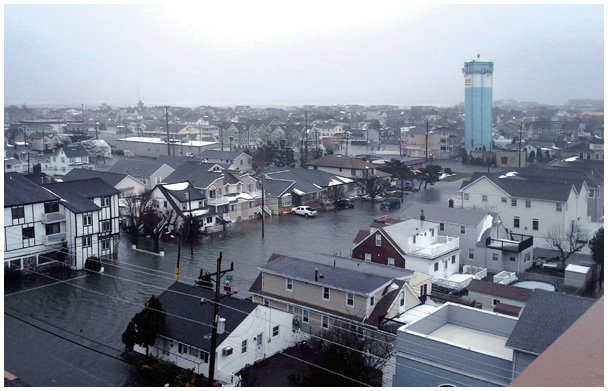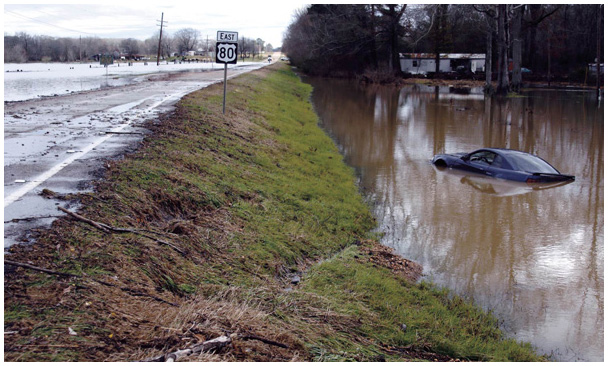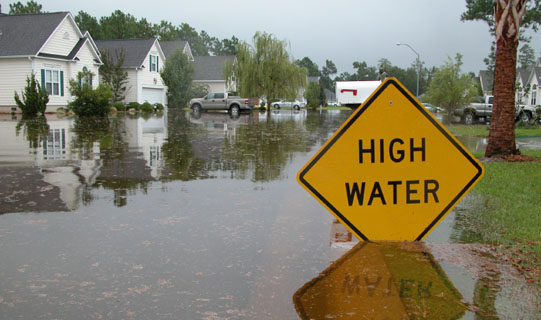The last time the National Flood Insurance Program'sauthorization ran out, it took 17 short-term extensions, fourlapses and nearly four years before the program was at lastreauthorized in July 2012.
|This time, the feeling is that things will be different.Legislators appear eager to get to work on extending and reformingthe NFIP, and the industry is more prepared and more willing thanever to get involved in the Flood insurance market and assume agreater share of the risk — which is key to the reformscontemplated by Congress.
|Tom Santos, vice president of federal affairs for theWashington-based American Insurance Association, said thatlast time, Congress, as it often does, waited until the last minuteto discuss the NFIP and then other issues emerged — such as thefinancial crisis in 2008 — that overshadowed Flood, contributing tothe environment of temporary extensions and program lapses.
|While the NFIP's authorization does not expire until September2017, The Housing and Insurance Subcommittee of the House'sFinancial Services Committee already held two hearings on the issuein January. The subcommittee's chairman, Rep. Blaine Luetkemeyer,R-Mo., said there is broad recognition that the “status quo isn'tacceptable” as it relates to the NFIP.
|The program is $24 billion in debt, which is driving bipartisanconsensus among legislators that something needs to be done toprotect taxpayers from any further burden. The focus of the secondhearing on Jan. 13, in fact, was on finding ways to accomplish thisby getting the private market more involved.
|And if there is momentum in Washington to encourageprivate-sector involvement in Flood coverage, perhaps the biggestdevelopment in NFIP discussions this time around is that theprivate sector is all ears. Tom Glassic, vice president, policy andgovernment relations for the Chicago-based Property CasualtyInsurers Association of America, said, “In the mid 2000s, if youtalked to the major insurers about offering primary Flood orfirst-dollar Flood, those were fighting words.”
|Today, that's changed. Robert Hartwig, president of the New YorkCity-based Insurance Information Institute, said theindustry's abundance of traditional and alternative capital — and arecent history of very large amounts of catastrophe risk beingtransferred to private reinsurers and capital markets fromstate-run insurers such as the Tallahassee, Fla.-based FloridaCitizens Property Insurance Corp. — are driving private-sectorinterest in Flood.
|Hartwig noted that technological advancements allow for bettermodeling of Flood risk. Better modeling, he added, also makes Floodmore attractive to capital market players interested in catastropherisks.
|Another factor is Washington's recognition during the program'slast renewal that heavily subsidized NFIP rates pose a majorbarrier for private insurers. Don Griffin, vice president, personallines for PCI, says the last renewal, the Biggert-Waters FloodInsurance Reform Act of 2012 (BW-12), “was the first timeCongress was somewhat willing to deal with the fact that theindustry couldn't get in because it couldn't be competitive basedon rates charged by NFIP.”
|BW-12 included a move toward more actuarially sound rates, and“the industry sees that as a sign that maybe they can get in there,be competitive and make it work,” Griffin added.
| Private sector regulation and interest
Private sector regulation and interest
Although the industry and Congress would seem to share the goalof bringing in the private sector, “the devil is in the details,”said John Dickson, president of Advanced Insurance Coverages, aunit of Kalispell, Mont.-based National Flood Services. “Thelong and short of it is there is agreement the program needssupport and a different direction. But the precise nature of thatdirection is still in debate.”
|One potential concern with greater private-sector involvement isadverse selection: If the private market comes in and writes NFIPrisks it believes could be profitable, the NFIP may be left withthe least favorable policies, putting taxpayers “in a moredifficult spot than they are now,” noted Charles Symington, seniorvice president, external and government affairs for the Alexandria,Va.-based Independent Insurance Agents and Brokers ofAmerica.
|Several experts cited a figure that just 1% of propertieswritten by the NFIP is responsible for 30% of losses. Expertsacknowledged the private sector would likely not be interested inwriting that 1%.
|Both Dickson and Griffin pointed to Florida Citizens' take-outprogram as a possible way forward.
|“Maybe the private market could take blocks of business out ofthe program,” Griffin said. “That way, they would get some of thegood with the bad.”
|Other ideas floated include transitioning the NFIP to either atrue residual market or a reinsurer of last resort, similar to theTerrorism Risk Insurance Act.
|Move to Homewners'?
|At the Housing and Insurance Subcommittee's Jan. 13 hearing,Birny Birnbaum, executive director of the Austin,Texas-based Center for Economic Justice, proposed eliminatingthe NFIP and transitioning risks to the private sector by havingCongress stipulate that Flood coverage must be included inHomeowners' and Commercial Property policies. His statementsindicated that adverse selection wouldn't be a possibility, butrather a certainty, if the NFIP exists side-by-side with privatecompetitors. He says the industry has the capital and know-how totake on Flood without putting the program and taxpayers at anyfurther risk.
|While Birnbaum acknowledged rates would go up for homeowners inhigh-risk areas under his proposal, he said federal spending couldbe shifted from providing subsidies to these policyholders topaying for mitigation efforts instead, which would addresslong-term exposure issues and control their insurance rates byreducing their risk to flooding.
|Other witnesses at the hearing favored smaller steps, notingthat the private Flood market is very small at the moment and itwould take time to see how insurers evaluate and write therisk.
|Most in the insurance industry support HR 2901, the FloodInsurance Market Parity and Modernization Act, which clarifiesBW-12 language that allowed privately issued Flood insurance tomeet mandatory purchase requirements. Santos said there wasconfusion about definitions in BW-12, and insurers were unable tobring products to market based on how banks viewed privateinsurance and interpreted the law.
|The bill also clarified that policies issued by eligiblenon-admitted insurers would meet mandatory purchase requirements,allowing surplus lines carriers to participate in the market.
| Birnbaum, at thehearing, opposed the idea of surplus-lines carriers writingPersonal Flood because their rates would not be subject toregulatory oversight, but Glassic told NU that private Floodcoverage would likely only get off the ground in the surplus linesmarket. Once admitted carriers see there is money to be made, thenthey may enter the market and compete.
Birnbaum, at thehearing, opposed the idea of surplus-lines carriers writingPersonal Flood because their rates would not be subject toregulatory oversight, but Glassic told NU that private Floodcoverage would likely only get off the ground in the surplus linesmarket. Once admitted carriers see there is money to be made, thenthey may enter the market and compete.
Ultimately, experts said, it's too early to tell which directionlegislators may go and what the NFIP will look like come October2017. And while much of the talk is about the program's debt andthe need for big changes, some offered perspective on the NFIP'sfiscal issues: “We often see comments about the program being $24billion in debt,” Neal Conolly, president of the St. Petersburg,Fla.-based Wright Flood Services, said. Though the programspans 47 years, he said “there are really only two events thatcreated that deficit.”
|Hurricane Katrina in 2005, he noted, saddled the program withmore than $17 billion in debt while 2012's Superstorm Sandy addedmore than $6 billion.
|“If you take those two events out, the program has actually beensound,” Conolly added.
|Furthermore, Conolly sayid Congress is usually quick toauthorize large sums of disaster funding after a significant event,costs that the NFIP helps control.
|“What I think people fail to focus on is if there wasn't anNFIP, the $24 billion in deficit is likely to have been two tothree times higher because there would have been no insuranceprogram and yet Congress may have felt itself politically compelledto provide disaster relief to the same losses that are at leastpartially insured by the NFIP,” Conolly said.
|It's a point Ian Macartney, Marsh's Flood InsuranceServices Practice leader, echoed.
|“How much more disaster assistance would the U.S. have paidwithout that program?” he asked, adding he is a strong supporter ofthe NFIP.
|Symington said there are certainly blemishes when it comes tothe NFIP, but that legislators have to be careful about preservingwhat has worked.
|“Let's be cautious,” he said. “Let's do our homework, and ifwe're going to look at major reforms, let's not do any harm.Because we all know there are ripple effects when there are majorchanges.”
|Legislators got a good look at ripple effects when BW-12 nudgedthe NFIP toward actuarial rates.
|“As soon as FEMA followed the statute, particularly in coastalresidential areas, people saw their rates jump dramatically,” hesaid. “Biggert-Waters froze the real estate market in many coastalareas.”
|| This resulted inthe Homeowner Flood Insurance Affordability Act of 2014, whichrescinded or delayed many of BW-12's rate increases. But that acthad some ripple effects of its own. Glassic says HFIAA included a$25 surcharge on flood policies for primary homes and a $250surcharge on second homes and businesses to make up revenue lostfrom the delayed rate increases.
This resulted inthe Homeowner Flood Insurance Affordability Act of 2014, whichrescinded or delayed many of BW-12's rate increases. But that acthad some ripple effects of its own. Glassic says HFIAA included a$25 surcharge on flood policies for primary homes and a $250surcharge on second homes and businesses to make up revenue lostfrom the delayed rate increases.
PCI's Glassic and Griffin maintained the $250 charge hasnegatively impacted voluntary Flood insurance take-up for favorablelower risk second homes ever since.
|Conolly explained, “The voluntary policies in particular arevery inexpensive relative to the risk.” This makes a $250 hikesignificant, he continued, causing a high number of people toreconsider purchasing coverage.
|Declining take-up
|That issue and others, such as remapping in some counties, havecombined to drive down the NFIP's policy count to around 5.1million from 5.5 million a couple of years ago. Again, experts seethe private market potentially helping with declining take-up.
|Martin Hartley, CEO of the White Plains, N.Y.-based PUREInsurance, said the private market could make buying a policyeasier.
|“Buying an NFIP policy is painful,” he said.
|As a write-your-own company that writes and services NFIPpolicies, he said, “We try to make it as painless as possible, butit's still much more challenging than it could be. And thatobstructs the sale.”
|Voluntary take-up could be increased with the private sectorbringing options to the table that would simplify Flood cover.
|“The process of getting a quote and binding a policy with theNFIP is hard work,” Hartley said. “You really have to want it.”
|In general, Hartley said, “I think the introduction of moreprivate competition — if you open it up, [private competitors] willcome, and I think by their very nature they will come up withsolutions we haven't thought of yet.”
|| Neal Schmidt,vice president of the Bala Cynwyd, Pa.-based PhiladelphiaInsurance Cos., said that in addition to being an NFIP provider andoffering excess commercial Flood coverage, his company has beenwriting Commercial Flood as part of a property package policy forrisks in favorable flood zones, and has a commercial primary Floodprogram for favorable risks in more difficult flood zones thatoffers broader coverage than the NFIP.
Neal Schmidt,vice president of the Bala Cynwyd, Pa.-based PhiladelphiaInsurance Cos., said that in addition to being an NFIP provider andoffering excess commercial Flood coverage, his company has beenwriting Commercial Flood as part of a property package policy forrisks in favorable flood zones, and has a commercial primary Floodprogram for favorable risks in more difficult flood zones thatoffers broader coverage than the NFIP.
He said the company has been offering its own coverages forabout three years, which he said puts Philadelphia “a little aheadof the curve. And he, too, said he is seeing more interest inflood.
|“I think there's definitely more interest from private insurers.Certainly more now than previously,” Schmidt said.
|“While there is that appetite, this is a complicated risk toinsure,” Santos said. “I think we are looking at a fairlysignificant transition period if we can even get [to a robustprivate market]. This isn't going to happen overnight, even ifthere is a private market willing to take on some of thisrisk.”
|For one, he noted, FEMA holds all loss data, which insurerswould need for underwriting.
|As for the future of the NFIP, although experts are unsure wherediscussions will end up, they are happy the conversation is alreadygetting started, and that key issues such as mapping, privatesolutions and affordability have already been raised inhearings.
|Symington said, “All indications are they're going to spend alot of time on it this year and try to get ahead of the deadline.Many times they run up against deadlines, so we want to thank theFinancial Services Committee for getting out of the gateearly.”
|Hartwig stated his preferred outcome: “If all goes well, after2017 we'll see more carriers and capacity in this market, morecompetition and at the same time, less of a burden on the U.S.taxpayer.”
|Complete your profile to continue reading and get FREE access to CUTimes.com, part of your ALM digital membership.
Your access to unlimited CUTimes.com content isn’t changing.
Once you are an ALM digital member, you’ll receive:
- Critical CUTimes.com information including comprehensive product and service provider listings via the Marketplace Directory, CU Careers, resources from industry leaders, webcasts, and breaking news, analysis and more with our informative Newsletters.
- Exclusive discounts on ALM and CU Times events.
- Access to other award-winning ALM websites including Law.com and GlobeSt.com.
Already have an account? Sign In
© 2024 ALM Global, LLC, All Rights Reserved. Request academic re-use from www.copyright.com. All other uses, submit a request to [email protected]. For more information visit Asset & Logo Licensing.









